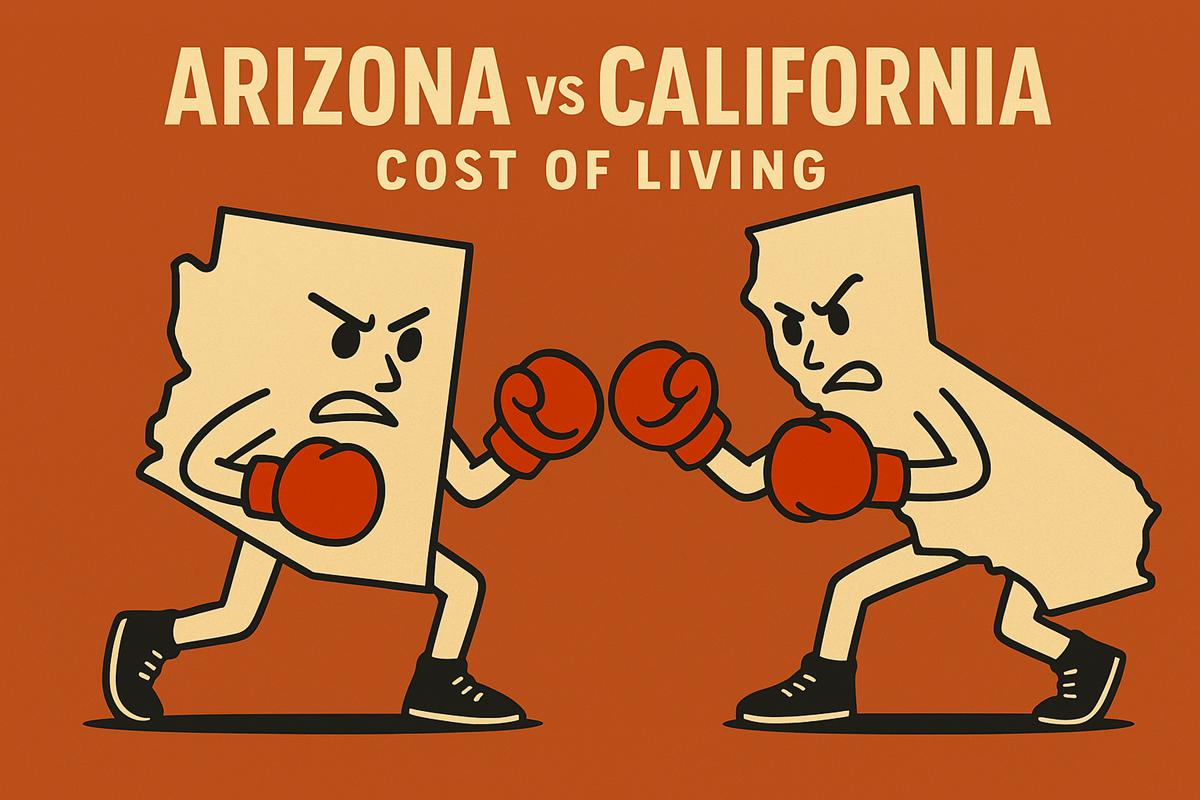Arizona Vs California: A True Cost Of Living Ultimate Showdown
Arizona vs California Cost of Living
Many people are curious about the cost of living differences between Arizona and California when deciding where to settle. While both states offer unique benefits and lifestyles, there is a noticeable contrast in expenses.
Arizona is significantly more affordable than California, with housing, groceries, and transportation costs being notably lower. This makes it an attractive option for those looking to stretch their dollars further.
California's appeal often lies in its diverse landscape, employment opportunities, and cultural offerings. However, these perks come with a higher price tag, especially in cities like San Francisco and Los Angeles. Even everyday expenses tend to add up more quickly, impacting savings and disposable income.
By contrast, Arizona offers a more budget-friendly lifestyle without sacrificing the benefits of sunny weather and scenic beauty. This can make a big difference for individuals or families who prioritize financial stability and simpler living.
Each state has its own allure, but it's clear that Arizona provides a more economical living situation compared to the high costs found in much of California.
Cost of Living Overview
The cost of living varies significantly between AZ and CA. Arizona generally presents a more affordable lifestyle, particularly in housing and daily expenses.
Cost of Living Index
The Cost of Living Index helps compare how expensive it is to live in one place versus another.
In California, the index tends to be higher due to elevated costs in cities like San Francisco and Los Angeles. Key expenses such as housing, utilities, and transportation contribute to this.
Arizona, with cities such as Phoenix and Tucson, offers a lower index. Here, housing and daily necessities are more budget-friendly.
Overall, Arizona's cost of living index reflects a more economical living environment compared to California.
Median Household Income
Median household income plays a pivotal role in assessing living standards. California's median household income is relatively high. This reflects its diverse job market, especially in tech regions like Silicon Valley.
In contrast, Arizona's median income is lower, aligning with a more modest cost structure. Despite earning less on average, Arizona residents often find their purchasing power sufficient to meet daily needs due to lower living costs.
The difference in incomes should be weighed against expenses, impacting overall financial well-being in each state.
Inflation Rates
Inflation affects the cost of goods and services over time. Both Arizona and California have experienced inflation, influencing living expenses in unique ways.
California faces higher pressures from inflation due to its complex economy and higher demand for resources, raising costs especially in urban areas.
Arizona, being generally less expensive, experiences slower inflation impacts.
The variance in inflation rates affects how quickly prices for essentials like groceries and housing rise.
Understanding these inflation differences is key for anticipating future costs and planning finances in these states.
Housing and Rent
Comparing the cost of housing and rent between AZ and CA reveals significant differences. Prices in major cities like San Francisco are much higher than in places like Phoenix.
Housing Market Comparison
California's housing market is known for its high prices, especially in cities like San Francisco and San Diego. The median home price in San Francisco is often over $1 million.
In contrast, Arizona offers more affordable options. Phoenix, for example, has median home prices around $459,000.
This stark difference influences where people choose to live. While California's coastal cities attract people with their amenities, the high cost of housing can be a barrier. Arizona, on the other hand, offers more space and newer developments for the same price.
Average Rent Prices
Rent prices show a similar pattern. San Francisco and San Diego have some of the highest rents in the nation. A one-bedroom apartment in San Francisco can cost over $3,000 per month. In San Diego, it may be closer to $2,500.
Meanwhile, Phoenix offers more affordable options. A one-bedroom apartment in Phoenix rents for around $1,500 monthly.
This difference makes Arizona appealing for renters looking for more budget-friendly options. The lower rent in Arizona allows residents to allocate their income to other needs more easily than in California's costly urban areas.
Real Estate Trends
Trends in the real estate market also differ between these states.
California often experiences high demand, leading to bidding wars and rapidly increasing prices. This is particularly true in tech hubs like San Francisco.
In Arizona, areas like Phoenix see steady growth, attracting both individuals and companies looking for affordable deals.
New housing communities and developments are common in Arizona, providing modern living spaces at lower prices.
These trends highlight the ongoing migration of people who seek more value for their investments. These trends often drive rental price fluctuations and influence long-term housing markets.

Taxes and Financial Considerations
When comparing the two states, several financial aspects stand out. Tax policies and rates can significantly affect living costs. Here’s a closer look at state taxes, property taxes, and sales taxes.
State Tax Policies
California’s state income tax is known for its progressive structure with rates reaching as high as 13.3%, the highest in the nation. This impacts high-income earners the most, making living in California more costly for those with substantial salaries.
In contrast, Arizona maintains a simpler tax system with a flat income tax rate. As of recent adjustments, the state reduced its rate to 2.5%.
This provides savings for both middle and higher-income individuals, making Arizona appealing for those looking to lessen income tax liabilities.
Property Taxes
Property taxes in California are affected by the Proposition 13 law, which limits tax increases to 2% per year based on the property's purchase value. This law keeps property taxes relatively predictable, though property values and associated taxes can be high.
Arizona offers lower property tax rates overall compared to California. They are based on home value assessments similar to California but lack restrictive caps like Proposition 13, allowing for more flexible adjustments.
Homeowners in Arizona often pay less in yearly property taxes, which can be a deciding factor for prospective buyers.
Sales Taxes
Sales tax in California typically ranges from 7.25% to as much as 10% in specific local areas. These rates are among the highest in the U.S., contributing to a higher cost of living related to day-to-day purchases.
In Arizona, sales tax rates are generally lower, with state rates around 5.6%, and local rates bringing it up to 8.6% in some regions.
This difference helps reduce the cost of goods and services for residents, benefiting those who prioritize fiscal savings on consumption.
Transportation Costs
When comparing transportation costs between the two states, consider factors such as public transit options, vehicle ownership expenses, and the overall transportation index. These elements vary significantly and can impact the cost of living in each state.
Public Transit Systems
The Grand Canyon State and the Golden State have distinct public transit systems.
Metropolitan areas like Phoenix offer Valley Metro, with bus and light rail services. Fares are reasonable, making it an affordable option for commuters.
In contrast, California boasts extensive networks like BART in the Bay Area and Metro in Los Angeles. These systems cover larger areas and often have higher ticket prices. Monthly passes in California might be more expensive, reflecting the broader coverage and higher operational costs.
Vehicle Ownership Expenses
Owning a vehicle involves costs like registration, insurance, and gas.
Arizona generally offers lower vehicle expenses. Car registration fees are relatively affordable. Insurance rates may also be lower due to a different risk assessment compared to California.
California, with its larger cities, may see higher insurance premiums. Gas prices in California are often higher due to state taxes. This results in increased fuel costs impacting overall vehicle expenses.
Transportation Index
The transportation index reflects the total cost of transport-related expenses.
Arizona's index is typically lower due to cheaper vehicle registration and fuel costs. This makes commuting and personal travel more economical.
California tends to have a higher index, largely due to expensive vehicle ownership costs and extensive public transit infrastructure. The need to accommodate a larger population in urban areas contributes to these elevated expenses. This makes California generally more costly in terms of transportation.
Daily Living Expenses
Arizona often boasts a lower cost of living compared to Cali, especially in everyday expenses. Food and groceries, healthcare, and utilities show noticeable differences between the two states, affecting household budgets significantly.
Grocery and Food Prices
In Arizona, groceries are generally more affordable than in California. Common products like milk, bread, and eggs tend to have lower price tags across cities in the state. Farmers' markets and local producers contribute to this affordability.
In contrast, California experiences higher grocery costs driven by factors such as larger urban locations and higher demand.
These price differences impact the typical shopping bill. For families, the grocery budget can stretch a bit farther in Arizona without sacrificing quality. Whether it's fresh produce, meats, or packaged goods, households in Arizona benefit from reasonable costs.
Health Care Costs
Health care expenditures often weigh heavier on the pocket in California due to the state's higher cost of living. Services ranging from doctor visits to prescription medications tend to incur higher fees.
Arizona, on the other hand, offers a more wallet-friendly healthcare market.
Insurance premiums in Arizona typically come at lower rates, which benefits residents widely.
For those needing regular medical services, the cost variations impact long-term planning and savings. The quality of healthcare services, though important, sees different pricing across these states.
Utility Bills
Utility costs reveal another clear distinction between Arizona and California.
Basic services such as electricity, water, and gas show competitive pricing in Arizona. Arizona’s warm climate leads to high air conditioning usage, but overall utility rates remain relatively low.
In California, large urban centers and stricter regulations contribute to higher utility bills.
Residents in Arizona can enjoy moderate utility costs year-round. This lower rate paired with energy efficiency considerations makes living expenses more manageable for those residing in the state.
Lifestyle and Leisure
Arizona and California offer diverse lifestyles with unique cultural experiences, outdoor adventures, and culinary delights. People residing in these states can enjoy a vibrant mix of activities that cater to different interests and tastes.
Culture and Entertainment
California is home to famous cultural hubs like Los Angeles and San Francisco. These cities offer world-famous theaters, art galleries, and music festivals.
Arizona, while quieter, boasts a rich Native American heritage with cultural centers and museums showcasing this history. Phoenix and Tucson have lively arts scenes, with local theaters and festivals celebrating regional culture.
Both states are known for their sports teams and events, providing plenty of entertainment options for sports fans.
Outdoor Activities
California’s coastline provides opportunities for surfing, beach outings, and coastal hikes.
Inland, the Sierra Nevada mountains offer skiing and snowboarding.
Arizona is renowned for its desert landscapes, including the spectacular Grand Canyon.
Hiking, biking, and exploring national parks like Saguaro and Petrified Forest are popular activities.
Both states have plenty of sunny days, making outdoor recreation a year-round possibility.
Dining and Cuisine
California’s cuisine is diverse, driven by its multicultural population and abundant fresh produce.
Farm-to-table dining is popular, and cities like Los Angeles and San Francisco are known for their culinary innovation.
Arizona’s food scene is influenced by Mexican and Native American flavors.
Tucson’s food heritage has been recognized by UNESCO. It offers unique dishes like Navajo tacos and flavorful salsas.
Both states have an array of dining options, from high-end restaurants to casual eateries, suiting various tastes and budgets.

Job Market and Employment
Both states offer varying opportunities in the job market.
California, known for its vibrant economy, leads in sectors like technology and finance, while Arizona provides appealing options with its growing business landscape and lower living costs.
Technology Sector Opportunities
California, notably Silicon Valley, is a global hub for tech innovation.
Companies like Apple, Google, and Facebook are headquartered here, offering numerous high-paying jobs.
The state attracts top talent worldwide due to its dynamic environment and investment opportunities.
In Arizona, cities like Phoenix and Tucson are expanding in tech, mainly driven by lower operational costs.
Companies such as Intel and Microchip Technology play a significant role.
While Arizona's tech opportunities are smaller in scale, they are growing steadily.
Finance Industry Landscape
California's finance industry is robust, especially in cities like San Francisco and Los Angeles.
Here, numerous banks, investment firms, and financial startups offer diverse roles.
The state's financial services are known for innovation and a wide range of career paths, attracting professionals nationwide.
Arizona's finance sector is developing with firms like American Express and Charles Schwab having significant operations.
The state's business-friendly climate encourages growth in this sector, providing jobs that benefit from proximity to California's market while enjoying Arizona's lower costs.
Unemployment Rates and Trends
California experiences fluctuations in unemployment rates due to its varied economy, but generally, it has a more stable job market given its strong economic diversity.
High living costs, however, may influence employment trends and job availability.
Arizona's unemployment rates are typically lower, offering a more stable job environment for residents.
The state's emphasis on growth and attraction of new industries helps maintain this stability, providing more job opportunities amidst its expanding economic landscape.
State Comparisons and Rankings
Arizona and California have distinct differences when it comes to the cost of living. Arizona is generally more affordable, with housing and taxes being key factors.
California, on the other hand, is known for its higher expenses across various categories.
These differences become more evident when compared to other states and viewed through national rankings.
Comparison with Other States
When comparing Arizona to other states, it becomes clear that it maintains a moderate cost of living.
States like Mississippi, West Virginia, and Arkansas are generally cheaper, but Arizona provides a more balanced space for affordability and amenities.
On the other hand, California consistently ranks among the most expensive states.
Its costs are often higher than places like Ohio, Kentucky, and Louisiana. While California offers a dynamic lifestyle and economic opportunities, these come with significant costs in housing, transportation, and daily expenses.
National Cost of Living Rankings
California often appears near the top of national cost of living indices due to high expenses, especially in regions like the Bay Area and Los Angeles.
This makes it one of the most costly states alongside New York and Massachusetts, pushing the index upward due to real estate and taxation.
In contrast, Arizona ranks around the middle according to national statistics.
It provides a more affordable alternative for those seeking a balance between cost and quality of life without the hefty financial demands seen in Connecticut or New York.
The relatively lower expenses make Arizona an attractive option for many families and retirees.
Frequently Asked Questions
Arizona is often more affordable than California due to lower housing costs. Many move to Arizona for financial reasons, including tax benefits and cost of living differences, especially important for retirees seeking cost savings.
What are the average monthly living costs in Arizona versus California?
Arizona generally has lower monthly living expenses compared to California.
The cost of housing, groceries, and transportation is typically less in Arizona. This makes it a more budget-friendly option for many families and individuals.
How do taxes compare between living in Arizona and living in California?
Taxes in Arizona are generally lower than in California.
This includes both income tax rates and property taxes. California's state income tax can be one of the highest in the nation, which can significantly affect take-home pay.
What are the financial benefits of retiring in Arizona versus California?
Retiring in Arizona offers several financial advantages, like lower housing costs and taxes.
Arizona's cost of living is generally cheaper, allowing retirees to stretch their savings further than they might in California.
Why is Arizona considered a popular destination for people relocating from California?
Arizona is popular among Californians for its affordable living expenses.
The lower costs, especially in housing and taxes, attract many looking for a more cost-effective lifestyle without sacrificing quality of life.
What is the difference in take-home pay between California and Arizona?
Take-home pay can be higher in Arizona due to lower state income taxes.
Californians may find a significant portion of their salary going to state taxes, which isn't as much the case in Arizona. This means more disposable income for Arizonans.
What are the main advantages and disadvantages of living in Arizona compared to California?
Arizona offers the advantage of a lower cost of living and taxes. However, California might provide more job opportunities in certain industries, like technology and entertainment.
The choice between the two states often depends on individual priorities related to cost and career opportunities.


















